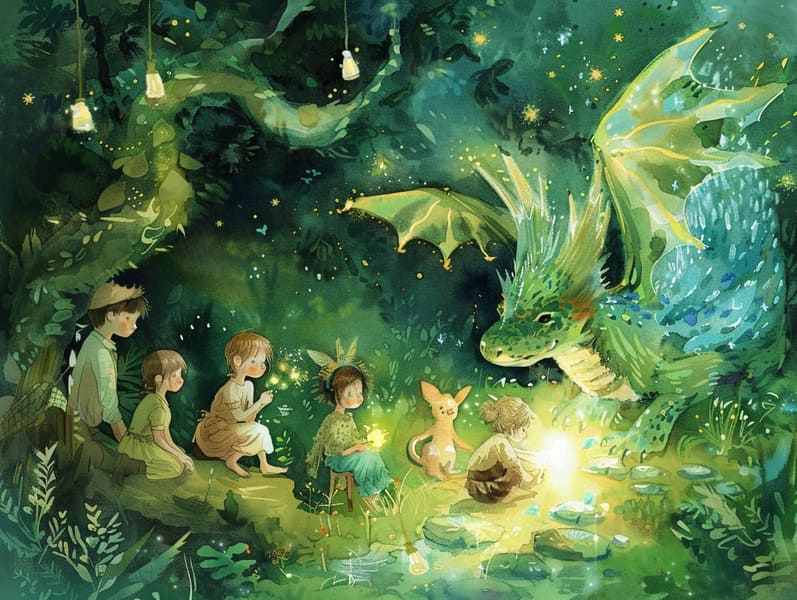
Historical fairy tales have deep roots. These tales have been passed down from one generation to the next centuries before they were ever published. They emerged from a variety of backgrounds, including Indigenous traditions. They were initially shared among elders, often carrying themes and messages reflective of the societal norms and beliefs of the time.
The renowned Brothers Grimm, Jacob and Wilhelm, were among the first to collect and release many of these beloved narratives. Their collection, "Grimm's Fairy Stories," included classics like "The Story of Cinderella," "The Bread Crumb Trail," and "Snow-White and Rose-Red," which have since become essentials in the world of famous fairy tales. Similarly, Andersen's whimsical stories, such as "The Story of the Little Mermaid," and "The Duckling's Story," have captured hearts worldwide, ensuring their place in the pantheon of treasured fairy tales.
Though they are old, classic fairy tales remain as important as ever, especially as kids' bedtime tales. These charming stories are now available in many formats, including artistically illustrated books, enchanting animations, and digital fairy tales.
Their lasting appeal can be credited to several magical reasons:
Key Lessons: Classic fairy tales often illustrate important moral lessons. Tales like "The Boy Who Cried Wolf" teach the significance of truth, while "The Tale of the Tortoise and the Hare" illustrate the qualities of determination and humility. These tales offer the young clear distinctions between truth and falsehood, helping to shape their moral compass in a soft yet important way.
Kindness and Comprehension: Classic fairy tales frequently present individuals facing struggles and tests, urging young listeners to sympathize with their struggles and celebrate their triumphs. For instance, "Beauty and the Beast" highlights the significance of seeing beyond the surface to appreciate the true nature of a individual, building sympathy and perception.
Cultural Awareness: Many old fairy tales are interwoven with the cultural contexts from which they sprang. Immersing in these narratives can provide intriguing perspectives into different societies, strengthening a sense of global understanding and acknowledgment.
Imagination and Innovation: The magical elements in ancient fairy tales—magical beings—foster children’s inventiveness. These fairy tales lead readers to magical realms, firing up creative dreams and a sense of enchantment that endures a lifetime.
Ancient fairy tales are not only bewitching but also teaching. They work as magical tools in promoting various mind and heart abilities in young ones. When timeless fairy tales are told out loud, they strengthen speech development by showing new vocabulary and detailed sentence structures. This practice also cultivates auditory skills and attentiveness, as kids track the narrative, looking forward to see what happens next.
Furthermore, contemplating the themes and characters of ancient fairy tales can nurture thought processes and evaluative skills. Children are led to identify patterns, anticipate outcomes, and comprehend cause and effect. These debates also assist young readers verbalize their thoughts and feelings, enhancing their emotional intelligence.
In today’s high-tech era, the prevalence of online storybooks has made these tales more obtainable than ever. Websites and applications make available ample collections of Grimm's fairy tales that can be enjoyed or listened through anytime, anywhere. Fairy tales read out loud are particularly liked, sharing an interactive way for little ones to appreciate these fascinating tales. Sound books and read-to-me stories lead characters and settings to life, often accompanied by spellbinding harmonies and songs that enrich the tale journey.
The timeless appeal of timeless fairy tales lies in their ability to modify to modern society while continuing with their central messages. Contemporary updates of these stories often highlight more diverse protagonists and modern settings, making them familiar to today’s audience. However, the underlying themes of fearlessness, humanity, and integrity remain unchanged, continuing to influence young readers of all ages.
Fairy tales also offer a sense of peace and comprehensibility. They impart upon a well-arranged narrative with a straightforward beginning, middle, and end, often concluding with the solving of conflicts and the triumph of morality over wickedness. This foreseeability can be consoling for young ones, making available a sense of stability in an ever-changing world.
Classic fairy tales continue to fascinate and inform new generations, maintaining their beauty and applicability in modern society. As kids' bedtime tales, they put forth a perfect blend of magic and knowledge, supporting moral values, empathy, and creativity. The proliferation of digital fairy tales and the widespread nature of fairy tales read out loud confirm that these ancient stories remain within reach to new generations.
By holding onto and recounting these tales, we continue to honor the rich tapestry of cultural heritage and cultural heritage. Whether you are perusing a richly illustrated book, perusing a digital library, or listening to an audio story, the allure of old fairy tales is always within reach. These narratives highlight of the unceasing magic of stories and its ability to tie us across time and space.
Whether you are accessing a richly illustrated book, perusing a virtual collection, or listening via check it out an read-aloud story, the loveliness of Grimm's fairy tales is always within reach.
These fairy tales emphasize of the unending impact of narratives and its ability to bring us together across eras and regions, establishing a link that enchants and educates alike.
Comments on “Uncovering the Past of Fairy Tales with Its Endless Grandeur.”